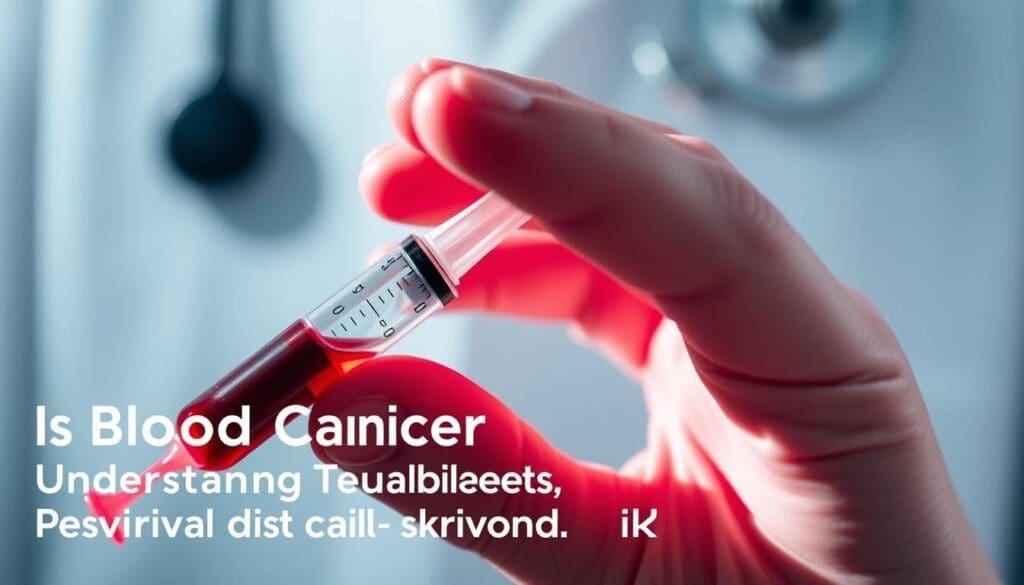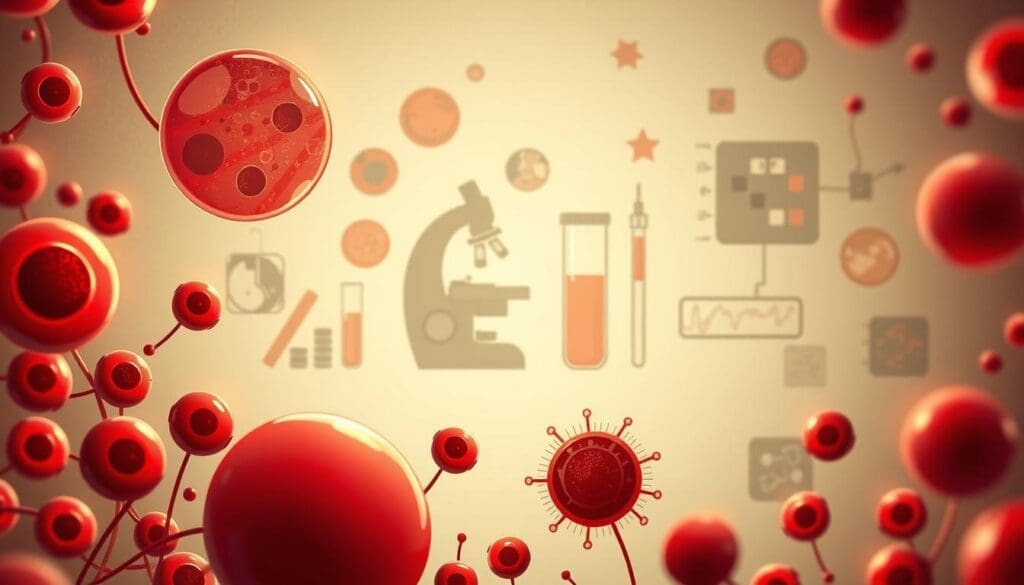Last Updated on November 17, 2025 by Ugurkan Demir

Blood cancer, which includes leukemia, lymphoma, and myeloma, is getting better thanks to new treatments. These treatments are more precise and target cancer cells directly.
The World Health Organization (WHO) says blood cancers are a big problem worldwide. Leukemia and lymphoma are among the top 10 cancers globally. At LivHospital, we aim to give top-notch care and support. Many patients ask, does blood cancer curable, and we continuously explore new treatments and research to improve outcomes and find a potential cure.

Blood cancer is not just one disease. It’s a group of disorders that affect the blood, bone marrow, and lymphatic system. Knowing the different types of blood cancer is key to finding the right treatment.
Blood cancer, also known as hematologic cancer, happens when blood cells are made abnormally. This can cause many health problems, depending on the type of cell and the abnormality.
Key characteristics of blood cancer include:
Blood cancers are mainly divided into three types: leukemia, lymphoma, and myeloma. Each type has its own features and affects different parts of the blood and lymphatic system.
| Type of Blood Cancer | Description | Affected Area |
| Leukemia | Cancer of the blood and bone marrow | Blood, Bone Marrow |
| Lymphoma | Cancer of the lymphatic system | Lymph Nodes, Spleen |
| Myeloma | Cancer of plasma cells in the bone marrow | Bone Marrow |
Blood cancer starts with genetic mutations that cause abnormal blood cell growth. These mutations can come from genetic factors, certain chemicals, or viral infections.
The way blood cancer progresses depends on the type and individual factors. It can lead to anemia, infections, and bleeding disorders if not treated.
Understanding the progression of blood cancer is key to managing it well and improving patient outcomes.

Leukemia is a complex blood cancer with many types and treatments. It’s not just one disease but a group of cancers affecting the blood and bone marrow.
Leukemia is divided into two main types: acute and chronic. Knowing the difference is key to choosing the right treatment.
Acute leukemia grows fast, leading to quick health decline without treatment. Chronic leukemia grows slower, with symptoms appearing gradually.
The type of leukemia affects treatment. Acute needs quick, strong treatment. Chronic might start with a gentler approach.
Treatment varies by leukemia type and patient health. For acute lymphoblastic leukemia (ALL), treatment often includes strong chemotherapy and sometimes stem cell transplant. Acute myeloid leukemia (AML) treatment also uses chemotherapy, with possible targeted therapy.
For chronic lymphocytic leukemia (CLL) and chronic myeloid leukemia (CML), new targeted therapies have made a big difference. These therapies have turned CML from a death sentence to a manageable condition for many.
Leukemia survival rates have greatly improved, thanks to better treatments. The five-year survival rate for ALL, and even more so for children, has significantly increased. CML treatment has also improved survival and quality of life.
While “cure” is complex in cancer, some leukemia types, like ALL in children and CML with targeted therapy, offer hope for long-term survival and even cure.
Lymphoma is a group of diseases, mainly Hodgkin’s and non-Hodgkin’s lymphoma. Knowing the difference between these types is key. It helps doctors choose the best treatment and predict the outcome.
Hodgkin’s lymphoma has Reed-Sternberg cells, special abnormal lymphocytes. It usually starts in one lymph node group and grows in order. Non-Hodgkin’s lymphoma, on the other hand, is more varied. It can start in any lymphoid tissue and has many subtypes.
Key differences between Hodgkin’s and non-Hodgkin’s lymphoma include:
Treatment for lymphoma depends on the type, stage, and patient’s health. Hodgkin’s lymphoma often uses chemotherapy and radiation, leading to high cure rates, mainly for early-stage cases. Non-Hodgkin’s lymphoma treatment varies by subtype. It may include chemotherapy, immunotherapy, targeted therapy, and radiation.
| Lymphoma Type | Common Treatments | Five-Year Survival Rate |
| Hodgkin’s Lymphoma | Chemotherapy, Radiation | 85-90% |
| Non-Hodgkin’s Lymphoma | Chemotherapy, Immunotherapy, Targeted Therapy | 70-80% |
Hodgkin’s lymphoma is more curable, with a high success rate, mainly for early-stage cases. Non-Hodgkin’s lymphoma’s prognosis varies by subtype. Some subtypes have a better outlook than others.
New treatments like immunotherapy and targeted therapies have improved outcomes. Research keeps going to better understand lymphoma and find more effective treatments.
Multiple myeloma is a blood cancer that affects plasma cells in the bone marrow. It’s a tough disease to cure, but new treatments have made life better for patients. These advancements have improved how well patients do and their quality of life.
When cancerous plasma cells build up in the bone marrow, it’s called multiple myeloma progression. This can harm normal blood cell production. It can also cause bone damage, anemia, and make infections more likely.
Managing this disease means watching symptoms closely and changing treatments as needed. Doctors keep a close eye on patients to adjust treatments for the best results.
Treatment for multiple myeloma has changed a lot. It now includes both well-known and new therapies. Common treatments are:
New treatments bring hope. Research is looking into:
Thanks to better treatments, many patients can live with multiple myeloma like a chronic disease. This means regular check-ups, making lifestyle changes, and sometimes, ongoing treatment.
| Management Strategy | Description | Benefits |
| Regular Monitoring | Frequent check-ups and tests to track disease status | Early detection of changes or complications |
| Lifestyle Adjustments | Dietary changes, exercise, and stress management | Improved overall health and well-being |
| Maintenance Therapy | Ongoing treatment to keep the disease under control | Prolonged remission and reduced risk of relapse |
With a good management plan, patients with multiple myeloma can live full and meaningful lives. Despite the disease, they can stay active and happy.
To know if blood cancer can be cured, we need to look at the different types and stages. The cure rate for blood cancer varies. It depends on the type of cancer, the stage at diagnosis, and the patient’s health.
In blood cancer, a “cure” means the disease is gone, and the patient stays in remission for a long time. But, some blood cancers can come back even after treatment.
Remission is when the disease is controlled, and symptoms are gone or very small. The chance of getting remission or a cure changes with each type of blood cancer.
Some blood cancers can be cured with the right treatment. For example:
Early diagnosis and good treatment are key to curing these cancers.
For some blood cancers, a cure might not be possible with today’s treatments. Then, the goal is to manage the disease as a long-term condition. This aims to improve life quality and extend life.
Chronic Lymphocytic Leukemia (CLL) and Multiple Myeloma are examples. Treatment focuses on controlling the disease, easing symptoms, and keeping life quality good, not curing it.
It’s important to know your blood cancer type and talk about treatment goals with your doctor. This helps manage your expectations and make informed choices.
Medical research has led to new treatments for blood cancer. These therapies are boosting survival rates and improving life quality for those with blood cancer.
Targeted therapies are key in fighting blood cancers. They focus on cancer cells, not healthy ones. Precision medicine makes treatments fit each patient’s cancer. This method is showing great promise in treating leukemia and lymphoma.
Tyrosine kinase inhibitors (TKIs) are a big win for targeted therapy. They’ve changed the game for Chronic Myeloid Leukemia (CML) and some acute lymphoblastic leukemia (ALL). TKIs block specific enzymes, helping patients live longer.
Immunotherapy uses the immune system to fight cancer. CAR-T cell therapy is a big success in treating lymphoma and leukemia. It changes T cells to attack cancer cells.
Other immunotherapies, like monoclonal antibodies and checkpoint inhibitors, are also helping. They boost the immune system’s fight against cancer. This gives hope to patients with few treatment options.
Stem cell transplantation is a vital treatment for many. Advances have made it safer and more effective. Haploidentical stem cell transplantation has made more donors available, helping more patients.
Techniques and care after transplantation have gotten better. This has lowered risks and raised survival chances. Researchers are working to make stem cell transplantation even better for blood cancer patients.
Advances in targeted therapies have changed the outlook for CML patients. What was once a dire prognosis is now a manageable condition. Chronic Myeloid Leukemia (CML) is a blood cancer that has seen significant treatment advancements in recent decades.
In the past, a CML diagnosis was often seen as fatal. But targeted therapies have greatly improved the prognosis for CML patients. Targeted drugs have turned CML from a fatal diagnosis to a chronic, manageable condition. This allows patients to live active and fulfilling lives.
“The introduction of tyrosine kinase inhibitors (TKIs) has revolutionized the treatment of CML, giving patients a near-normal life expectancy.”
Targeted therapies, like TKIs, have been key in improving CML treatment outcomes. These drugs target the molecular abnormality causing CML, the BCR-ABL tyrosine kinase.
| TKI Generation | Examples | Impact on CML Treatment |
| First Generation | Imatinib | Significantly improved survival rates |
| Second Generation | Dasatinib, Nilotinib | Enhanced efficacy, reduced resistance |
| Third Generation | Ponatinib | Effective against resistant CML |
With modern treatments, CML patients can now expect a near-normal life expectancy. Studies show that well-responsive patients have a life expectancy similar to the general population.
The success story of CML treatment shows the power of medical research and innovation. As treatments evolve, we can expect even better patient outcomes.
Medical progress is changing how we treat blood cancer. Survival rates give us clues about how well patients do. It’s key for patients, families, and doctors to grasp these numbers.
Survival rates for blood cancer vary a lot. This depends on the type and how far along the disease is. For example, leukemia survival rates have gotten better over time.
Medical science has made big strides in treating blood cancer. This has led to better survival rates. Key factors include:
These advances have changed the game for many patients. They can now manage their disease better and live longer.
Survival stats are helpful but must be seen in the light of each patient’s situation. Age, health, genetic markers, and how well a patient responds to treatment all matter.
We suggest patients and their families talk to doctors. This way, they can get a clearer picture of their chances.
Knowing what affects blood cancer prognosis is key for both patients and doctors. Many things play a big role in how well someone with blood cancer will do.
Age is a big deal when it comes to blood cancer. Younger people usually do better than older ones. This is because older folks might have other health problems that make treatment harder. Overall health matters too, as those with fewer health issues can handle treatments better.
Genetic and molecular markers give important clues about blood cancer. Some genetic changes mean the cancer might grow faster or respond better to certain treatments. For example, some changes in chromosomes can change how well leukemia patients do.
How well you do after the first treatment is a big sign of how you’ll do long-term. Those who get rid of all cancer cells after the first treatment usually do better. Early response to treatment often means the cancer is more likely to be treatable.
Getting care from experts can really help with blood cancer. Places that specialize in blood cancers often have better results. These centers have teams of experts and can try new treatments through clinical trials.
Understanding these factors helps patients and doctors make better choices about treatment and what to expect.
Living with blood cancer means getting care that covers treatment and support for your well-being. It’s important to know about remission, cure, and survivorship as you deal with this disease.
It’s key to know the difference between remission and cure when you have blood cancer. Remission means the disease is controlled, and symptoms are gone or less. A cure means the disease is gone for good, and you won’t get it back.
Remission is often the main goal of treatment, even if a cure isn’t possible. It helps patients manage their condition and live active lives. But, the term “cure” is used carefully because it depends on many things, like the cancer type and how well you respond to treatment.
For many, blood cancer is a chronic condition that needs ongoing care. This means regular check-ups, sticking to treatment plans, and making lifestyle changes to keep your quality of life good.
| Management Strategies | Description | Benefits |
| Regular Monitoring | Frequent check-ups and tests to track disease progression | Early detection of changes, allowing for timely intervention |
| Treatment Adherence | Following prescribed treatment plans | Effective disease management, reducing symptoms and complications |
| Lifestyle Adjustments | Making healthy lifestyle choices, such as diet and exercise | Improved overall well-being, enhanced resilience |
The growing number of blood cancer survivors in America shows how far medical care has come. With over 500,000 survivors, there’s a big community that’s changing what it means to live with cancer.
These survivors are not just living longer; they’re living better lives because of the care they get. Their stories of hope and strength inspire others and show why we need to keep researching and supporting blood cancer patients.
Blood cancer is a serious disease, but thanks to medical research, treatments have gotten better. Now, there are more options for patients to fight the disease.
It’s important to understand blood cancer treatment and living with it. Working with a dedicated team and staying updated on new treatments helps. This way, patients can have the best chance of success.
Thanks to new treatments like targeted therapies and immunotherapy, the future looks brighter for blood cancer patients. We should celebrate the progress made and look forward to more discoveries. This gives hope to those fighting blood cancer.
The chance of curing blood cancer varies by type and stage. Medical research and technology have boosted survival rates and quality of life for many.
Some blood cancers can be cured, while others are chronic. Treatment success varies by cancer type.
Leukemia’s curability depends on its type. Acute leukemia needs quick treatment, while chronic leukemia is managed long-term. New treatments have greatly improved survival chances.
Blood cancer curability varies. Some types, like leukemia and lymphoma, might be curable. Others need ongoing care.
Treatments include targeted therapies, immunotherapy, and stem cell transplants. The right treatment depends on the cancer type and stage.
New medical research and technology have brought innovative treatments. These have improved patient outcomes and survival rates.
Blood cancer survival rates have risen over time. Five-year survival rates differ by cancer type. Knowing these stats helps patients understand their diagnosis and treatment.
Age, health, genetic markers, and treatment response affect prognosis and curability. Understanding these factors helps patients make informed choices.
CML is not curable in the traditional sense. But modern treatments have made it manageable. This allows patients to live active, fulfilling lives.
Remission means the disease is controlled, but not gone. A cure means the disease is eradicated. Knowing the difference is key for patients to navigate their care.
Blood cancer can be deadly, but treatment advances have improved survival. Prognosis depends on the disease type and stage.
Patients can manage blood cancer with a dedicated medical team and staying updated on treatments. This way, they can lead active lives despite the condition.
Some blood cancers are curable, while others need ongoing care. Curability depends on the disease type and stage.
Yes, leukemia is treatable. Various treatments are available based on the disease type and stage.
Leukemia’s cure possibility varies by type. Some types might be curable, while others require ongoing management.
Subscribe to our e-newsletter to stay informed about the latest innovations in the world of health and exclusive offers!